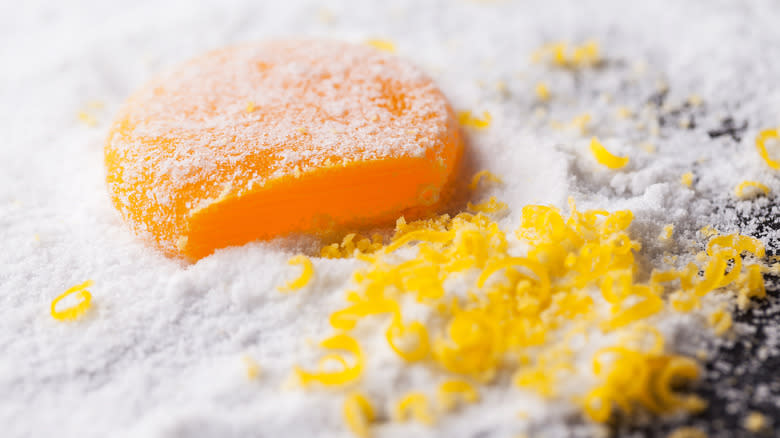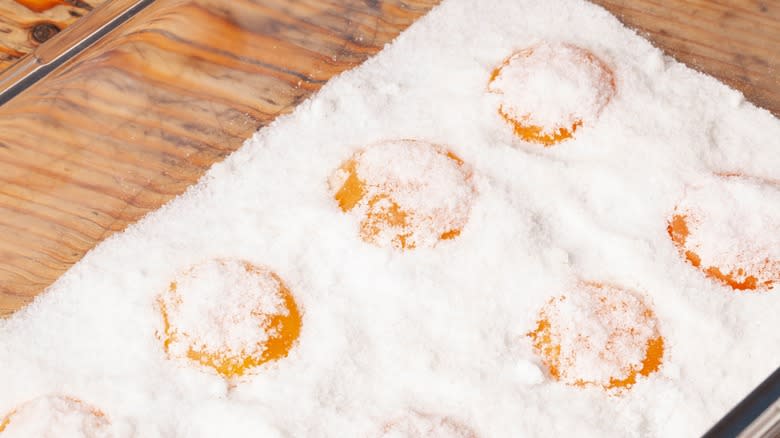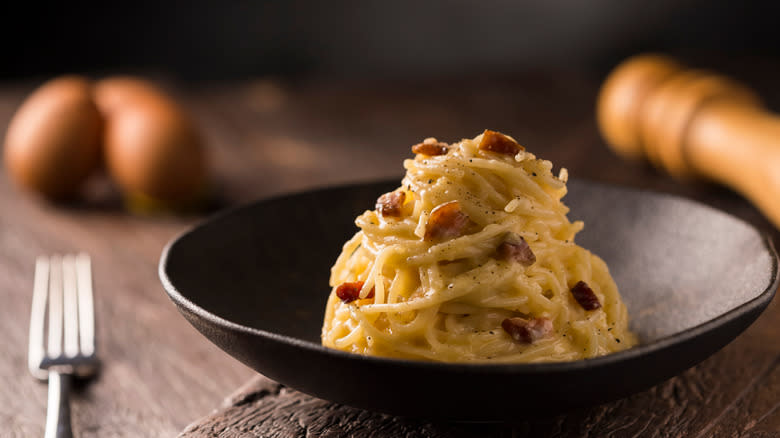Leftover Egg Yolks? Time To Start Curing

A carton of eggs is a mainstay in most refrigerators. They're easy to use, rich in nutrients, and a great bang for your buck. Plus, there are hundreds of ways to prepare them, from your basic omelet and egg salad to quiches, casseroles, and sweet meringues. If you've been making plenty of egg white omelets or have recently done some baking that only requires the whites, you may need to do something with leftover egg yolks. For a sophisticated preparation and increased shelf life, you may want to consider curing them.
If unfamiliar, a cured egg yolk is one that's been buried beneath a bed of salt and refrigerated until it is semi-solid in texture. This process slowly extracts the moisture from the yolk, while also concentrating its richness and flavor. Afterward, the yolks are rinsed of their salt and baked in an oven at a low temperature until stiffened into a semi-hard consistency that's similar to a hunk of cheddar cheese. The process takes time, but your efforts will be rewarded with a fun and funky ingredient that you can grate atop salads, soups, or pastas for some added complexity and punch.
Read more: The 20 Best Egg Brands, Ranked
How To Properly Cure Your Egg Yolks

Curing egg yolks is a relatively simple process; all you need is a delicate hand, a few supplies, and some patience. In terms of equipment, a medium-sized baking dish, drying rack, and baking sheet will do the trick. If you're not confident about dividing the egg white from the yolk, then a plastic egg separator may also be helpful. The ingredient list is short, too: Large eggs and enough sea salt to cover them from top to bottom. You can also add seasonings like black pepper or sugar to the salt mixture to balance the flavor of the yolk, but this is optional.
For the curing process, pour half the salt into the baking sheet and make circular indentations with the back of a spoon. Separate the egg whites, and gently slide the yolks into each well. Cover the yolks with more salt until completely buried, and enclose the dish with some plastic wrap before storing it in the refrigerator for four to five days. Afterward, thoroughly rinse the salt from each yolk under cold water (they won't break, but still be gentle). Set your oven to its lowest temperature and allow the eggs to dry out for an hour or two, or until they turn a hazy shade of pale yellow. Store in your refrigerator and grate or slice like you would a piece of cheese.
Using Those Cured Yolks

Cured egg yolks contribute a rich eggy flavor that can elevate any number of dishes, but due to their intensity, they should be used more as a condiment, topping, or garnish rather than as the star of the plate. All that being said, there's a ton that you can do with cured yolks. The simplest way to use them is in place of finishing salt. Grate some of the cured yolks over a platter of roasted vegetables, steak tartare, or a piece of buttered bread for a refreshing pop of salinity. Another excellent application is to use the cured yolk in the same way you would a wedge of Parmesan, grating it over salads, pasta, pizzas, risottos, or even soups and stews.
Consider incorporating grated cured egg yolks directly into a tuna or pasta salad or even into the mix for your next batch of hamburgers or meatballs. And if you're looking for some up-front cured egg flavor, then serve a yolk or two with your next charcuterie board, alongside the fruit, nuts, meat, and cheeses. Since they last for around a month in the fridge, you have plenty of time to experiment with this novel use of leftover egg yolks!
Read the original article on Daily Meal


